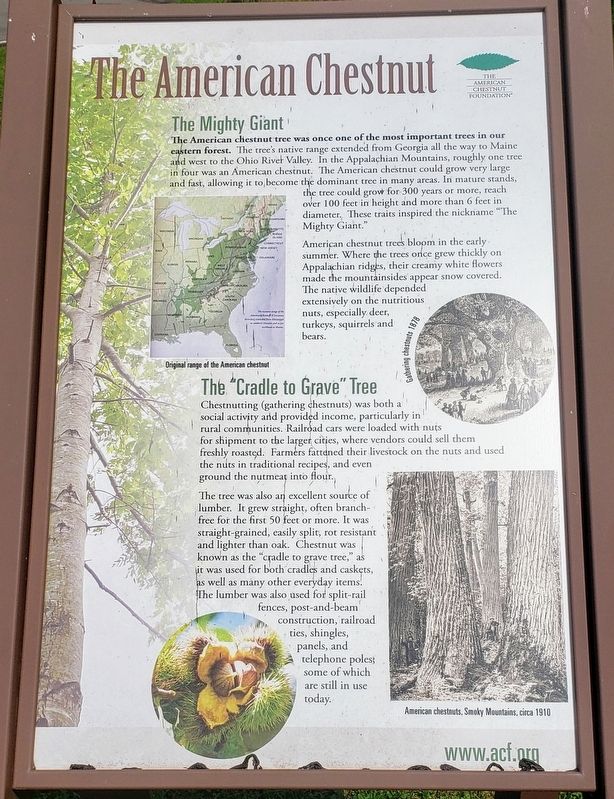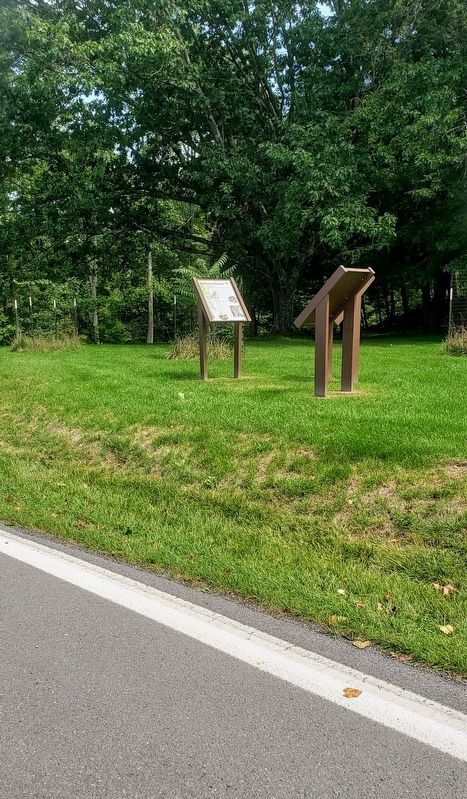Near Grafton in Taylor County, West Virginia — The American South (Appalachia)
The American Chestnut
The Mighty Giant
The American chestnut tree was once one of the most important trees in our eastern forest. The tree's native range extended from Georgia all the way to Maine and west to the Ohio River Valley. In the Appalachian Mountains, roughly one tree in four was an American chestnut. The American chestnut could grow very large and fast, allowing it to become the dominant tree in many areas. In mature stands, the tree could grow for 300 years or more, reach over 100 feet in height and more than 6 feet in diameter. These traits inspired the nickname "The Mighty Giant."
American chestnut trees bloom in the early summer. Where the trees once grew thickly on Appalachian ridges, their creamy white flowers made the mountainsides appear snow covered. The native wildlife depended extensively on the nutritious nuts, especially deer, turkeys, squirrels and bears.
The "Cradle to Grave” Tree
Chestnutting (gathering chestnuts) was both a social activity and provided income, particularly in rural communities. Railroad cars were loaded with nuts for shipment to the larger cities, where vendors could sell them freshly roasted. Farmers fattened their livestock on the nuts and used the nuts in traditional recipes, and even ground the nutmeat into flour.
The tree was also an excellent source of lumber. It grew straight, often branch-free for the first 50 feet or more. It was straight-grained, easily split, rot resistant and lighter than oak. Chestnut was known as the "cradle to grave tree,” as it was used for both cradles and caskets, as well as many other everyday items. The lumber was also used for split-rail fences, post-and-beam construction, railroad ties, shingles, panels, and telephone poles; some of which are still in use today.
(Photo Captions):
Original range of the American chestnut
Gathering chestnuts 1878
American chestnuts, Smoky Mountains, circa 1910
Erected by The American Chestnut Foundation.
Topics. This historical marker is listed in these topic lists: Environment • Industry & Commerce. A significant historical year for this entry is 1878.
Location. 39° 18.759′ N, 80° 1.753′ W. Marker is near Grafton, West Virginia, in Taylor County. Marker is on Paul E. Malone Road (County Route 9/7) 0.4 miles south of Parkview Road (County Route 44), on the right when traveling south. Marker is across the road from the parking area for Tygart River Dam. Touch for map. Marker is at or near this postal address: 530 Paul E Malone Road, Grafton WV 26354, United States of America. Touch for directions.
Other nearby markers. At least 8 other markers are within 2 miles of this marker, measured as the crow flies. Tygart Dam (within shouting distance of this marker); Anna Jarvis' Birthplace
(approx. 1˝ miles away); Ann Reeves Jarvis (approx. 1˝ miles away); Webster (approx. 1˝ miles away); Veterans Memorial (approx. 1.6 miles away); Grafton National Cemetery (approx. 1.6 miles away); A National Cemetery System (approx. 1.6 miles away); Grave of Thornsbury Bailey Brown (approx. 1.7 miles away). Touch for a list and map of all markers in Grafton.
Credits. This page was last revised on September 1, 2021. It was originally submitted on August 31, 2021, by Bradley Owen of Morgantown, West Virginia. This page has been viewed 163 times since then and 26 times this year. Photos: 1, 2. submitted on August 31, 2021, by Bradley Owen of Morgantown, West Virginia. • Bill Pfingsten was the editor who published this page.

